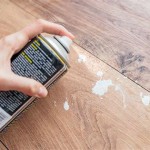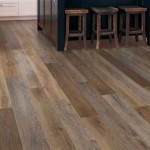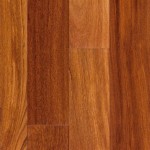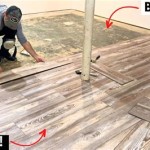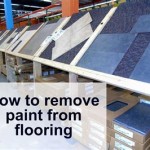Removing Carpet Tile Adhesive From Wood Floors: A Comprehensive Guide
The removal of carpet tile adhesive from wood floors presents a unique challenge. Unlike dealing with adhesive on concrete or other subfloors, wood requires a more delicate approach to avoid damaging the underlying material. The process involves carefully softening the adhesive and then gently lifting it away without scratching, gouging, or otherwise marring the wood surface. This article provides detailed instructions and insights into effectively removing carpet tile adhesive while preserving the integrity of the wood floor.
Before commencing any removal process, it is crucial to identify the type of adhesive used. While many carpet tile adhesives are water-based and relatively easy to remove, others can be solvent-based and significantly more stubborn. This identification will inform the selection of appropriate tools and techniques. Furthermore, it is essential to understand the type of wood flooring involved—whether it is solid hardwood, engineered wood, or laminate—as this also influences the choice of removal methods. Solid hardwood is generally more resilient, while engineered wood and laminate are more susceptible to damage from moisture and aggressive solvents.
Safety is paramount when undertaking any DIY project. Always wear appropriate personal protective equipment (PPE), including gloves to protect the hands from chemicals, safety glasses to shield the eyes from debris and splashes, and a dust mask or respirator to prevent inhalation of potentially harmful particles. Ensure adequate ventilation in the work area, especially when using solvents or heat, to avoid the buildup of fumes.
Preparing the Work Area
Prior to focusing on the adhesive itself, the immediate work area surrounding it requires careful preparation. This involves several key steps to minimize the risk of damage to the surrounding floor and to ensure a clean and efficient removal process.
The initial step is to remove any furniture or obstructions from the area. This provides ample workspace and prevents accidental damage to these items during the adhesive removal process. Next, thoroughly clean the floor around the adhesive. Use a vacuum cleaner to remove loose dirt, debris, and any remaining fragments of carpet tile. This prevents these particles from being ground into the wood surface during the scraping or cleaning stages, which could cause scratches.
Subsequently, protect the surrounding wood floor with painter's tape or masking film. This creates a barrier that prevents cleaning solutions, solvents, or other liquids from seeping into the seams of the floorboards and potentially causing damage. Overlap the tape slightly to ensure a secure seal. The extent of protection should extend beyond the immediate area of the adhesive, covering several inches of the surrounding floor to account for any accidental spills or splatters.
Softening the Adhesive
The key to successfully removing carpet tile adhesive without damaging the wood floor lies in effectively softening the adhesive. This makes it easier to lift the adhesive away without resorting to excessive force or abrasive tools that could scratch or gouge the wood. Several methods can be employed to soften the adhesive, each with its own advantages and disadvantages.
One common method involves using heat. A heat gun, set on a low setting, can be used to gently warm the adhesive, softening it and making it more pliable. It is crucial to maintain a safe distance between the heat gun and the floor, moving the gun constantly to prevent overheating and potential damage to the wood. Test the heat on an inconspicuous area first to gauge its effect on the wood finish. Avoid using a high heat setting or focusing the heat on one spot for too long, as this could scorch the wood or melt the adhesive, making it even more difficult to remove.
Another softening method involves using warm water and a mild detergent. Mix a small amount of detergent with warm water and apply it to the adhesive using a sponge or cloth. Allow the solution to sit for several minutes, giving it time to penetrate and soften the adhesive. Avoid using excessive water, as this could seep into the wood and cause it to swell or warp. After a few minutes, test a small area to see if the adhesive has softened sufficiently. If not, repeat the application and allow it to sit for a longer period. This is a gentler method than using heat and is less likely to damage the wood floor.
Some specialized adhesive removers are designed for use on wood floors. These products are formulated to dissolve the adhesive without harming the wood finish. However, it is essential to choose a product specifically labeled as safe for wood floors and to follow the manufacturer's instructions carefully. Always test the product in an inconspicuous area first to ensure that it does not damage or discolor the wood. Apply the remover according to the instructions, allowing it to sit for the recommended time, and then proceed with the removal process.
Removing the Softened Adhesive
Once the adhesive has been adequately softened, the actual removal process can begin. This step requires patience and care to avoid damaging the wood floor. Use appropriate tools and techniques to lift the adhesive away gently and effectively.
A plastic scraper or putty knife is ideal for removing softened adhesive. Plastic tools are less likely to scratch the wood surface compared to metal tools. Hold the scraper at a low angle and gently slide it under the edge of the softened adhesive, lifting it away from the floor. Avoid applying excessive pressure or forcing the scraper, as this could damage the wood. Work in small sections, removing the adhesive gradually. If the adhesive is resistant, reapply heat, water, or adhesive remover to soften it further.
For stubborn areas, consider using a nylon scrub brush. Dip the brush in warm water or adhesive remover and gently scrub the adhesive. The bristles of the brush can help to loosen the adhesive without scratching the wood. Use a circular motion and apply gentle pressure, working in small sections. Wipe away any residue with a clean cloth as you go. Be cautious not to saturate the wood with water or cleaning solution.
If small pieces of adhesive remain after scraping and scrubbing, a microfiber cloth dampened with warm water or adhesive remover can be used to remove them. Gently wipe the affected area, applying light pressure. Avoid using abrasive cleaners or scouring pads, as these can scratch the wood finish. Change the cloth frequently to ensure that it is clean and free of debris.
After removing the adhesive, thoroughly clean the area with a damp cloth to remove any remaining residue. Use a mild detergent solution if necessary. Dry the floor completely with a clean, dry cloth. Inspect the area carefully for any remaining adhesive or damage. If necessary, repeat the removal process on any stubborn areas or repair any minor scratches or imperfections in the wood finish.
The specific steps and products needed will depend on the type of adhesive that was used to adhere the carpet tiles to the floor. Some adhesives are relatively easy to remove and only require mild cleaning solutions and gentle scraping. Others are more tenacious and require more potent solvents and specialized tools.
After the cleaning phase is complete, it could be necessary to refinish certain sections or the entire floor. This may be necessary if the adhesive removal process resulted in damage to the existing finish, such as scratches, discoloration, or areas where the finish has been completely removed. Refinishing the floor will restore its original appearance and protect it from future damage.
Proper disposal of the removed adhesive and any used cleaning supplies is also important. Check local regulations for hazardous waste disposal to ensure that these materials are disposed of safely and responsibly. This protects the environment and ensures compliance with local laws.
Finally, consider applying a protective coating to the cleaned area. This will help to protect the wood floor from future stains and damage. Several types of protective coatings are available, including polyurethane, varnish, and wax. Choose a coating that is appropriate for the type of wood floor and the level of protection required.

Removing Glue Or Adhesive From Hardwood Floors The Speckled Goat

Which Tools And Methods Remove Old Carpet Tile Adhesive Best

Removing Glue Or Adhesive From Hardwood Floors The Speckled Goat

Removing Glue Or Adhesive From Hardwood Floors The Speckled Goat

How To Remove Glue From Wood Floors Pete S

4 Ways To Remove Adhesive From A Hardwood Floor Wikihow

How To Remove Carpet Glue And Floor Adhesive View Our Tips

How To Remove Carpet Glue From Wood Concrete Floors Ultimate Diy Guide

How To Remove Carpet Glue From Tiles Design Furniture

How To Remove And Replace A Carpet Tile
See Also
